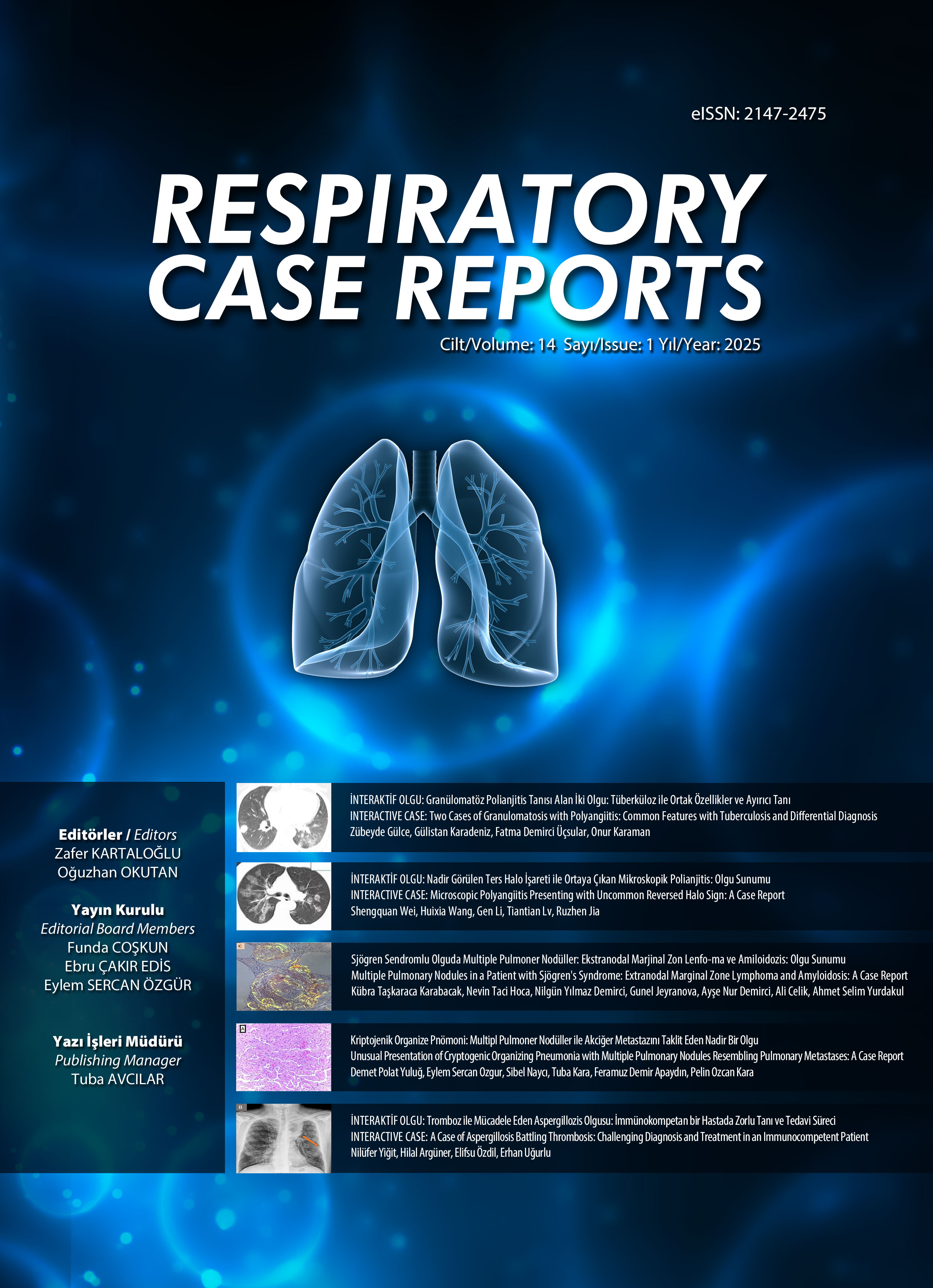e-ISSN 2147-2475

Volume: 12 Issue: 1 - February 2023
| CASE REPORT | |
| 1. | Catamenial Pneumothorax and Skin Endometriosis: A Case Report Ayman Ahmed, Fahad Al Amoudi, Abdulnasir Batuk, Sharafeldin Elaoni, Ahmed Shahin, Ataa Albaroudi doi: 10.5505/respircase.2023.09815 Pages 1 - 6 Catamenial pneumothorax (CP) is an uncommon disease that is challenging to diagnose and manage. It is characterized by recurrent episodes of spontaneous pneumothorax occurring periodically within 72 hours of menses in women of childbearing age. Treatment typically includes video-assisted thoracic surgery (VATS) and hormonal treatment. This case report is of a 37-year-old female who was presented with her fourth episode of recurrent right-sided pneumothorax, her two-year status post-VATS bullectomy, chemical and mechanical pleurodesis, and dienogest treatment. This case report details the natural history of a CP presentation with a high index of suspicion to diagnose, meticulous surgical exploration of the hemithorax, looking particularly for bullae and diaphragmatic pleural endometriosis or fenestrations, and application of both mechanical and chemical pleurodesis to prevent a recurrence. This report should encourage the combined adoption of chemical and mechanical pleurodesis during VATS in CP patients suffering from repeated recurrence. |
| 2. | A Rare Cause for Recurrent Pneumothorax: Birt-Hugg-Dubé Syndrome Merve Şengül İnan, Özgün Aran, Hakan Işık, Agbaba Ahmedov, Abdullah Sezer, Alper Gözübüyük doi: 10.5505/respircase.2023.03708 Pages 7 - 10 Birt-Hogg-Dube syndrome (BHDS) is a rare disease with autosomal dominant inheritance. A positive family history, recurrent pneumothorax, skin fibrofolliculomas, pulmonary cysts, and an increased risk of renal malignancy characterize it. The mutation in the folliculin gene is considered to be responsible for the development of this syndrome. This article aims to present a 40-year-old female BHDS patient with a recurrent pneumothorax, skin lesions, and positive family history. |
| 3. | Mediastinal Pigtail Catheterization for Treatment of Pneumomediastinum in a COVID-19 Patient: A Case Report Ashok P Arbat, Gauri Gadge, Sweta Chourasia, Parimal Deshpande, Swapnil Bakamwar doi: 10.5505/respircase.2023.37929 Pages 11 - 14 Spontaneous pneumomediastinum (SPM) is a decisive complication reported to be associated with COVID-19. Here, we present a case of SPM in a COVID-19-positive patient that was not caused by any iatrogenic or known reasons. At the time of admission, the patient was COVID-positive and distressed. He was immediately subjected to hematological and radiological investigations (chest X-ray, HRCT), which confirmed pneumomediastinum. The patient was hypoxic and hypotensive even after receiving ionotropic support. Considering the patient's critical condition, a mediastinal pigtail catheterization was performed instead of a thoracotomy, and the catheter was in situ for nine days. Arterial blood gas was monitored during the hospital stay, and supplementary oxygen therapy was provided accordingly. The patient subsequently recovered and was discharged. Hence, SPM in this COVID patient was treated by pigtail catheterization, and major surgical interventions were avoided. |
| 4. | A Case of Thoracic Splenosis Diagnosed with Spleen Scintigraphy Hasan Yavuz, Fatih Tamer, Akın Çinkooğlu, Ayşegül Akgün, Ufuk Çağırıcı doi: 10.5505/respircase.2023.23281 Pages 15 - 18 Splenosis is the autotransplantation of spleen tissue to different parts of the body following a traumatic spleen and diaphragmatic rupture. Thoracic localization is very rare, usually asymptomatic, and detected incidentally. This paper describes a patient who had nonspecific symptoms and was diagnosed with thoracic splenosis using imaging methods without any invasive procedures. In cases with a history of trauma and spleen or diaphragmatic injury secondary to trauma, thoracic splenosis should be suspected when any pulmonary, pleural, or intrathoracic space-occupying lesion is detected in the left hemithorax, and the diagnosis should be made by effective and minimally invasive exclusion of malignant lesions. |
| 5. | Secondary Pleural Hydatidosis as an Unexpected Cause of Fever of Unknown Origin Kaan Kara, Betül Kınık, Ebru Aykan, Hülya Abalı, Fatma Tokgoz Akyil, Seda Tural Onur doi: 10.5505/respircase.2023.34711 Pages 19 - 22 Fever of unknown origin (FUO) and hydatid cysts are both complex processes that require a lengthy diagnosis. Patients hospitalized with equivocal pyrexia and pleural effusion in endemic areas should keep this in mind. Hydatid cysts are a cause of FUO. Therefore, we present a rare case. Our patient was presented with an intermittent fever and cough. His left lung's middle and lower zones had reduced respiration noises. The hemogram revealed leukocytosis with neutrophil predominance and normochromic normocytic anemia. The levels of ALT, AST, CRP, and procalcitonin were all elevated. There was increased opacity in the appearance of an abscess on a chest X-ray, as well as pleural effusion. On CT, a 10x9.3 cm pleural-based cystic structure containing an airfluid level was observed. Thoracentesis fluid was exudative, neutrophil-dominated, and empyema. The indirect hemagglutination test was positive at a 1/2560 titer. Pleural fluid cytology revealed a cysthydatid membrane, and the patient was diagnosed with secondary pleural hydatosis. |
| 6. | Distinguishing Occupational and Environmental Asbestos Exposures: Case Series Merve Erol Gülseven, Gülden Sarı, Adem Koyuncu, Bilge Akgündüz, Funda Demirağ, Ceprail Şimşek doi: 10.5505/respircase.2023.28482 Pages 23 - 29 Asbestos is a flexible and fibrous silicate that is highly resistant to physical and chemical conditions. Because of these features, it has been utilized for many years in a variety of industries, including insulation, textiles, ships, vehicle production, and construction. Despite the fact that its usage is restricted in Turkey, as in many other countries, significant occupational exposures can occur during the repair of outdated industrial items and the demolition of buildings. Furthermore, environmental asbestos exposure is a major public health concern in several areas of Turkey. Therefore, it does not come to mind to question occupational exposures in the diagnosis of asbestos-related lung disease. The purpose of this article is to highlight the importance and necessity of questioning both occupational and environmental asbestos exposure, as well as some differences in the pathologies that environmental and occupational asbestos exposures may cause in the lungs of patients with asbestos-related disease. |
| 7. | Diffuse Idiopathic Pulmonary Neuroendocrine Cell Hyperplasia as a Rare Cause of Persistent Cough and Hemoptysis: A Case Report Lale Duman, Seher Susam doi: 10.5505/respircase.2023.63383 Pages 30 - 35 Diffuse idiopathic pulmonary neuroendocrine cell hyperplasia (DIPNECH) is an extremely rare but underdiagnosed pulmonary disorder at the benign end of the neuroendocrine cell proliferation spectrum of preinvasive lung lesions. The cause of DIPNECH is currently unknown. The diagnosis can be suggested when chest CT demonstrates characteristic findings, including multiple non-calcific bronchocentric random nodules and mosaic attenuation. DIPNECH should be considered in differential diagnoses of patients with pulmonary symptoms and chest CT findings of nodules with mosaic attenuation. It is vital to recognize it since it is thought to be a precursor of peripheral carcinoid tumors. Contrary to the literature, many peripheral carcinoid tumors developed relatively quickly and caused severe hemoptysis due to hypervascularity. The patient differs considerably from other cases in the literature regarding the clinical course, with bone involvement at the initial diagnosis and liver metastases that quickly spread and developed calcification. |
| 8. | Opportunistic Pathogen Francisella philomiragia Pneumonia Associated with Near-drowning Ayşenur Ertaş, Kübra Karaca, Şükrü Egemen Demir, Abdullah Kansu, Nurlana Mikayilova doi: 10.5505/respircase.2023.63370 Pages 36 - 39 Francisella philomiragia is a rare opportunistic pathogen that causes pneumonia and systemic infections in humans. There have been a few reports of F. philomiragia causing disease in humans, mainly in people with the chronic granulomatous disease, severe immunosuppression, or near drowning. We describe a 70-year-old diabetic man who almost drowned and got pneumonia from F. philomiragia. We also looked at other cases of F. philomiragia infections. |












